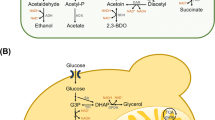Abstract
Reduction of bicyclo[2.2.2]octane-2,6-dione to (1R, 4S, 6S)-6-hydroxy-bicyclo[2.2.2]octane-2-one by whole cells of Saccharomyces cerevisiae was improved using an engineered recombinant strain and process design. The substrate inhibition followed a Han-Levenspiel model showing an effective concentration window between 12 and 22 g/l, in which the activity was kept above 95%. Yeast growth stage, substrate concentration and a stable pH were shown to be important parameters for effective conversion. The over-expression of the reductase gene YDR368w significantly improved diastereoselectivity compared to previously reported results. Using strain TMB4110 expressing YDR368w in batch reduction with pH control, complete conversion of 40 g/l (290 mM) substrate was achieved with 97% diastereomeric excess (de) and >99 enantiomeric excess (ee), allowing isolation of the optically pure ketoalcohol in 84% yield.




Similar content being viewed by others
References
Aguilera A (1986) Deletion of the phosphoglucose isomerase structural gene makes growth and sporulation glucose dependent in Saccharomyces cerevisiae. Mol Gen Genet 204:310–316
Almqvist F (1996) Synthesis of optically pure active bicyclo[2.2.2]octane derivatives—A study towards novel taxol mimetics and development of new chiral ligands for asymmetric catalysis. Doctoral thesis, Lund University
Almqvist F, Eklund L, Frejd T (1993) An improved procedure for the synthesis of bicyclo[2.2.2]octane-2,6-dione. Synth Commun 6:957–960
Almqvist F, Torstensson L, Gudmunsson A, Frejd T (1997) New ligands for the titanium IV-induced catalytic asymmetric reduction of ketones with catecholborane. Angew Chem Int Engl 4:376–377
Botes A, Harvig D, van Dyk M, Sarvary I, Frejd T, Katz M, Hahn-Hägerdal B, Gorwa-Grauslund MF (2002) Screening of yeast species for the stereo-selective reduction of bicyclo[2.2.2]octane-2,6-dione. J Chem Soc Perkin Trans 1:1111–1114
Chartrain M, Randolph G, Moore J, Reider P, Robinson D, Buckland B (2001) Asymmetric bioreduction: application to the synthesis of pharmaceuticals. J Mol Cat B: Enzym 11:503–512
Chin-Joe I, Nelisse PM, Straathof AJ, Jongejan JA, Pronk JT, Heijnen JJ (2000) Hydrolytic activity in baker’s yeast limits the yield of asymmetric 3-oxo ester reduction. Biotechnol Bioeng 69:370–376
Csuk R, Glänzer BI (1991) Baker’s yeast mediated transformations in organic chemistry. Chem Rev 91:49–97
D’Arrigo P, Pedrocchi-Fantoni G, Servi S (1997) Old and new synthetic capacities of baker’s yeast. Adv Appl Microbiol 44:81–123
de Souza Pereira R (1998) The use of baker’s yeast in the generation of asymmetric centers to produce chiral drugs and other compounds. Crit Rev Biotechnol 18:25–83
Han K, Levenspiel O (1988) Extended monod kinetics for substrate, product, and cell inhibition. Biotechnol Bioeng 32:430–437
Hilterhaus L, Liese A (2007) Building blocks. Adv Biochem Eng Biotechnol 105:133–173
Jayasinghe LY, Kodituwakku D, Smallridge AJ, Trewhella MA (1994) The use of organic solvent systems in the yeast mediated reduction of ethyl acetoacetate. Bull Chem Soc Jpn 67:2528–2531
Johanson T, Katz M, Gorwa-Grauslund MF (2005) Strain engineering for stereoselective bioreduction of dicarbonyl compounds by yeast reductases. FEMS Yeast Res 5:513–525
Karhumaa K, Hahn-Hägerdal B, Gorwa-Grauslund MF (2005) Investigation of limiting metabolic steps in the utilization of xylose by recombinant Saccharomyces cerevisiae using metabolic engineering. Yeast 22:359–368
Katz M, Sarvary I, Frejd T, Hahn-Hägerdal B, Gorwa-Grauslund MF (2002) An improved stereoselective reduction of a bicyclic diketone by Saccharomyces cerevisiae combining process optimization and strain engineering. Appl Microbiol Biotechnol 59:641–648
Katz M, Frejd T, Hahn-Hägerdal B, Gorwa-Grauslund MF (2003a) Efficient anaerobic whole cell stereoselective bioreduction with recombinant Saccharomyces cerevisiae. Biotechnol Bioeng 84:573–582
Katz M, Hahn-Hägerdal B, Gorwa-Grauslund MF (2003b) Screening of two complementary collections of Saccharomyces cerevisiae to identify enzymes involved in stereo-selective reduction of specific carbonyl compounds: an alternative to protein purification. Enz Microb Technol 33:163–172
Liese A (2002) Replacing chemical steps by biotransformations: industrial application and processes using biocatalysis. In: Drauz K, Waldmann H (eds.) Enzyme catalysis in organic synthesis. Wiley-VCH Verlag GmbH, Weinheim, pp. 1419–1459
Martin SF, White JB, Wagner R (1982) Alkoxide-accelerated sigmatropic rearrangements. A novel entry to the bicyclo[5.3.1.]undec-7-ene system of the taxane diterpenes. J Org Chem 47:3190–3192
Mori K, Nagano E (1990) Preparative bioorganic chemistry part 10. Asymmetric reduction of Bicyclo[2.2.2]octane-2,6-diones with baker’s yeast. Biocatalysis 3:25–36
Patel RN (2006) Biocatalysis: synthesis of chiral intermediates for drugs. Curr Opin Drug Discov Devel 9:741–764
Sarvary I, Almqvist F, Frejd T (2001) Asymmetric reduction of ketones with catecholborane using 2,6-BODOL complexes of titanium(IV) as catalysts. Chem Eur J 10:2158–2166
Sarvary I, Yiqian W, Frejd T (2002) Novel, cyclic and bicyclic 1,3-diols as catalysts for the diethylzinc addition to aldehydes. J Chem Soc Perkin Trans 15:645–651
Schmid A, Dordick JS, Kiener A, Wubbolts M, Witholt B (2001) Industrial biocatalysis today and tomorrow. Nature 409:258–268
Servi S (1990) Baker’s yeast as a reagent in organic synthesis. Synthesis 1–25
Stewart JD (2000) Organic transformations catalyzed by engineered yeast cells and related systems. Curr Opin Biotechnol 11:363–368
Widegren M, Dietz M, Friberg A, Frejd T, Hahn-Hägerdal B, Gorwa-Grauslund MF, Katz M (2006) The synthesis of bicyclo[2.2.2]octan-2,6-dione revisited. Synthesis Stuttgart 20:3527–3530
Acknowledgement
We would like to thank Dr. Ed Van Niel for help with the Han-Levenspiel kinetic model, Nora Bieler for her assistance with the bioreductions and Prof. Bärbel Hahn-Hägerdal for critically reading the manuscript.
Author information
Authors and Affiliations
Corresponding author
Rights and permissions
About this article
Cite this article
Johanson, T., Carlquist, M., Olsson, C. et al. Reaction and strain engineering for improved stereo-selective whole-cell reduction of a bicyclic diketone. Appl Microbiol Biotechnol 77, 1111–1118 (2008). https://doi.org/10.1007/s00253-007-1240-1
Received:
Revised:
Accepted:
Published:
Issue Date:
DOI: https://doi.org/10.1007/s00253-007-1240-1




